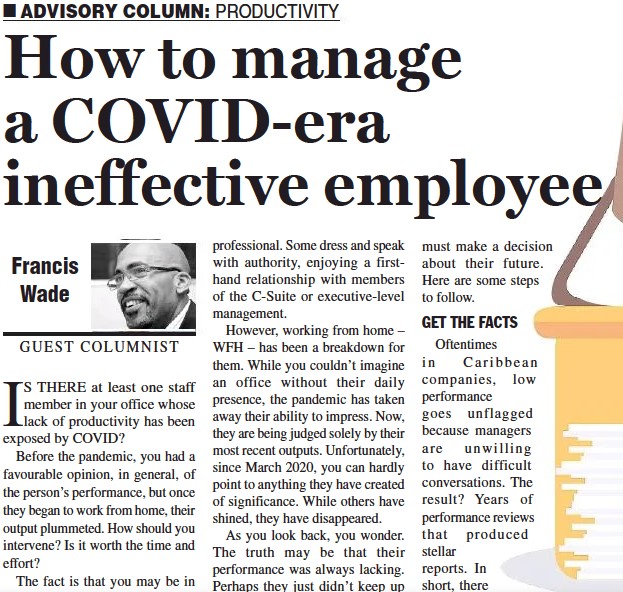Is there at least one staff member in your office whose lack of productivity has been exposed by COVID? Before the pandemic, you had a favorable opinion, in general, of the person’s performance. But once they began to work from home, their output plummeted. How should you intervene? Is it worth the time and effort?
The fact is, you may be in a bit of shock. In each company, there are employees with diplomatic skills who excel in social gatherings, are constantly active via email and get along with everyone. They’re always available to help, playing the role of a consummate corporate professional. Some dress and speak with authority, enjoying a first-hand relationship with members of the C-Suite.
However, working from home has been a breakdown for them. While you couldn’t imagine an office without their daily presence, the pandemic has taken away their ability to impress. Now, they are being judged solely by their most recent outputs. Unfortunately, since March 2020, you can hardly point to anything they have created of significance. While others have shined, they have disappeared.
As you look back, you wonder. The truth may be that their performance was always lacking. Perhaps they just didn’t keep up with technology. Or new knowledge. A few were living on past successes, reminding everyone of their historic value.
Sadly, you conclude that they had become experts in “keeping” rather than “doing” their job. Now, you must make a decision about their future. Here are some steps to follow.
- Get the facts
Oftentimes in Caribbean companies, low performance goes unflagged because managers are unwilling to have difficult conversations. The result? Years of performance reviews which produced stellar reports. In short, there may be no written record or warning of any issues whatsoever. Any discussions which hinted at a problem are, in the past, forgotten.
If this is the case, in the absence of any other information, it’s safe to assume that the employees have no idea they have fallen behind. While they may have personal, private suspicions, don’t speculate. Most employees care about doing a good job and have some degree of anxiety regarding their continued employment. Don’t presume an emotional state.
Instead, focus on the facts and separate them from any interpretations which you have added. If you need to write them down for the sake of clarity, do so. By the end, each factoid should pass the video-tape test: visible actions that could have been recorded if a camera were available.
If you recall incidents which took place before COVID versus those which showed up after, all the better. However, if you have no facts; stop. You can’t take further action until you can satisfy yourself (and others) that it’s all not just a figment of your imagination.
- Prepare for the Conversation
With the facts in front of you, take time to prepare to have a difficult conversation about what they mean. If you have never used a feedback model before, find one you feel comfortable with. I prefer the Observation-Impact-Suggestion framework as a kick-starter. It begins with the observed facts, continues with their impact, and concludes with a suggestion.
Practice this conversation opener with a colleague. Ask them for coaching to make it as effective as possible, even as they roleplay extreme reactions.
When the time comes, be ready to have a lengthy exchange with your employee to come to some sort of agreement on a way forward. Be prepared to help.
- Confront the Work from Home Reality
Beyond this individual’s performance lies the reasons why this discussion must be conducted in the first place. Performance management in most regional companies is weak, a fact which COVID has revealed. In response, some managers are itching to go back to the way things were, when they didn’t have to confront low-performers.
Make no mistake: the newly exposed low-performers also want to return to the safety of the office. Hence, both parties are in an awkward spot. But they will receive no mercy from the high-performers, who have found ways to motivate themselves during the pandemic. Freed from micro-management and wasteful commutes, they have shined brightly; some for the very first time.
What would it be like to have a full complement of self-motivated staff? If you commit to such an outcome, don’t simply lapse into business as usual, acting as if COVID was just an unwelcome interruption.
Instead, grasp it for the opportunity it is to transform the culture of your workplace. This bump in the road could be a catalyst for breakthrough results. Perhaps it’s an answer to your prayers.

